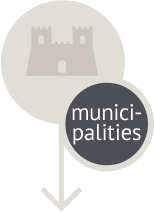The building of the municipal theatre was decided in February 1792 at an assembly of the Holy Congregation. It was planned by the architects Carlo Rusca from Treia and Giuseppe Lucatelli from Mogliano. The members of some noble and bourgeois families of the town signed a regular contract on 13 February 1794, in which they stated to cover the whole expenses for the building by promising a sack of wheat each for eight years. The area for the construction was that of St. Martino’s church oratory, belonging to the “Brotherhood of Mercy”.
As the area was in dilapidation, the church was demolished in August 1801 and the building land was purchased to construct the theatre. Much of the bricks of Saint Martino’s church were used again to build the cathedral. At the end of 1805, the roof of the theatre was finally terminated. On 17 August 1815, the works for the hall began and on 20 August 1817 the internal works were finished. Meanwhile, Patrizio De Mattia and Giambattista Bartoloni replaced the previous construction company. In 1865, the Roman painter Silverio Capparoni, the prestigious painter from Ancona Podesti’s disciple, depicted Corrado di Antiochia’s siege in the battle of Montecchio (the former name of Treia) on the curtain, inspired by a Tommaso Minardi’s picture, preserved in the Accademia Georgica. In 1881, a theatrical company, formed by the town people owning the stages, was founded and since then, the theatre became joint ownership.
Through the decree of the Ministry of Education, in December 1961, the theater of Treia was appointed “of particular important interest” under the act n.1089/1939. On December 1982, the “regional board of ministry of cultural heritage and environmental conservation of the Marches” included the theatre of Treia among the most historical of the region and approved the program for its restoration.
The works started in April 1983 but economic and bureaucratic difficulties undermined its continuation. In order to not compromise the works, since the theater was privately owned, in 1988, the 42 joint owners, with great generosity and civic sense, decided to cede their ownership shares and to grant administration of the theater to the Municipality of Treia for the modest sum of 1,000 liras each. Consequently, the theater became property of the Municipality of Treia for the modest sum of 42’000 liras. Press agencies and mass media became interested in this event.
The works have been finally completed and the town theater was inaugurated on 12 July 2002, by performing the play "Opera sull’acqua" in a national premiere. Returned to former glory and point of reference for the town people, the theater has finally returned to its entertaining role through its drama seasons, performed by nationally renowned companies. Over the years, the calendar of events has been complemented by music festivals, youth and Dialect Theater. Every season features about thirty events from November to July.
«La facciata del Teatro,sotto la cimasa ornata di globi, era percorsa dalla scritta Apollini et Musis. Io vedevo il polline di tutti i fiori e la Musa paradisiaca dipinta su per le scale della casa De Mattia… Sui plinti attaccavano le locandine. Correvo a leggere quegli annunzi, più che leggere ci restavo pensierosa davanti.“Serata d’onore del brillante”. Certo questo doveva scherzare sempre. “Serata d’onore della prima donna”. La prima donna! In due parole un nome solo, come Madonna, come Regina. Vedere il teatro! Tra tanti desideri questo di sicuro il più imperioso, perché fu l’unico che manifestai e continuavo a farlo».
Da “Giù la piazza non c’è nessuno” di Dolores Prato










